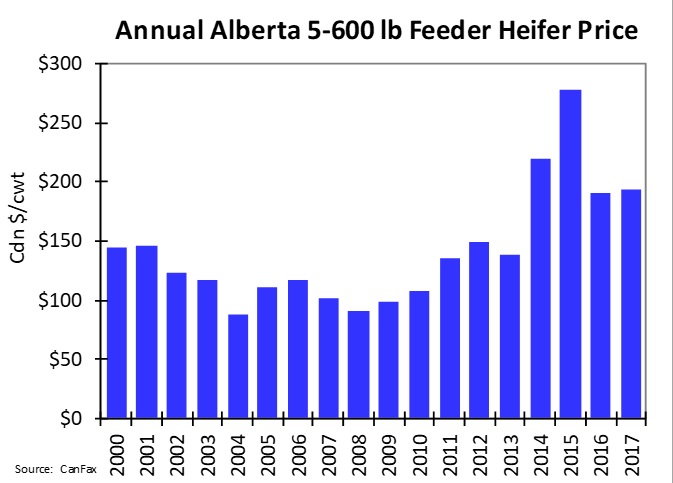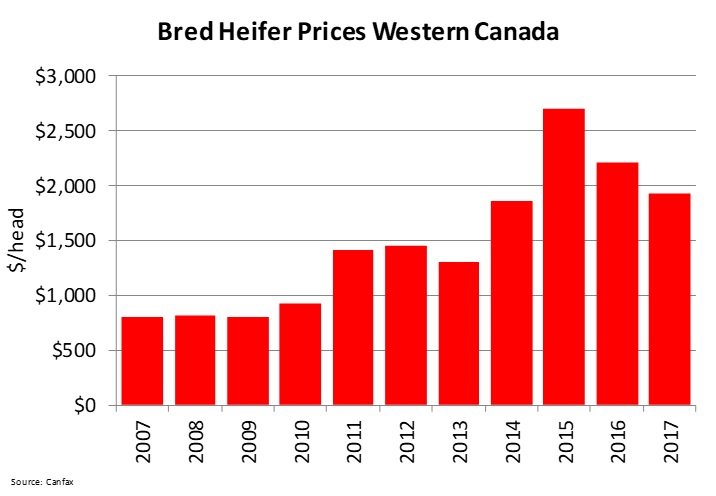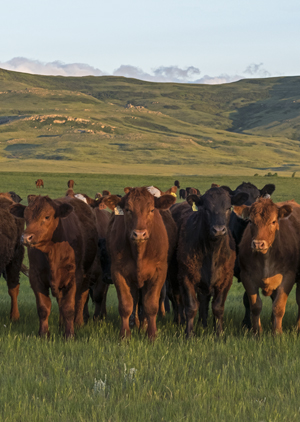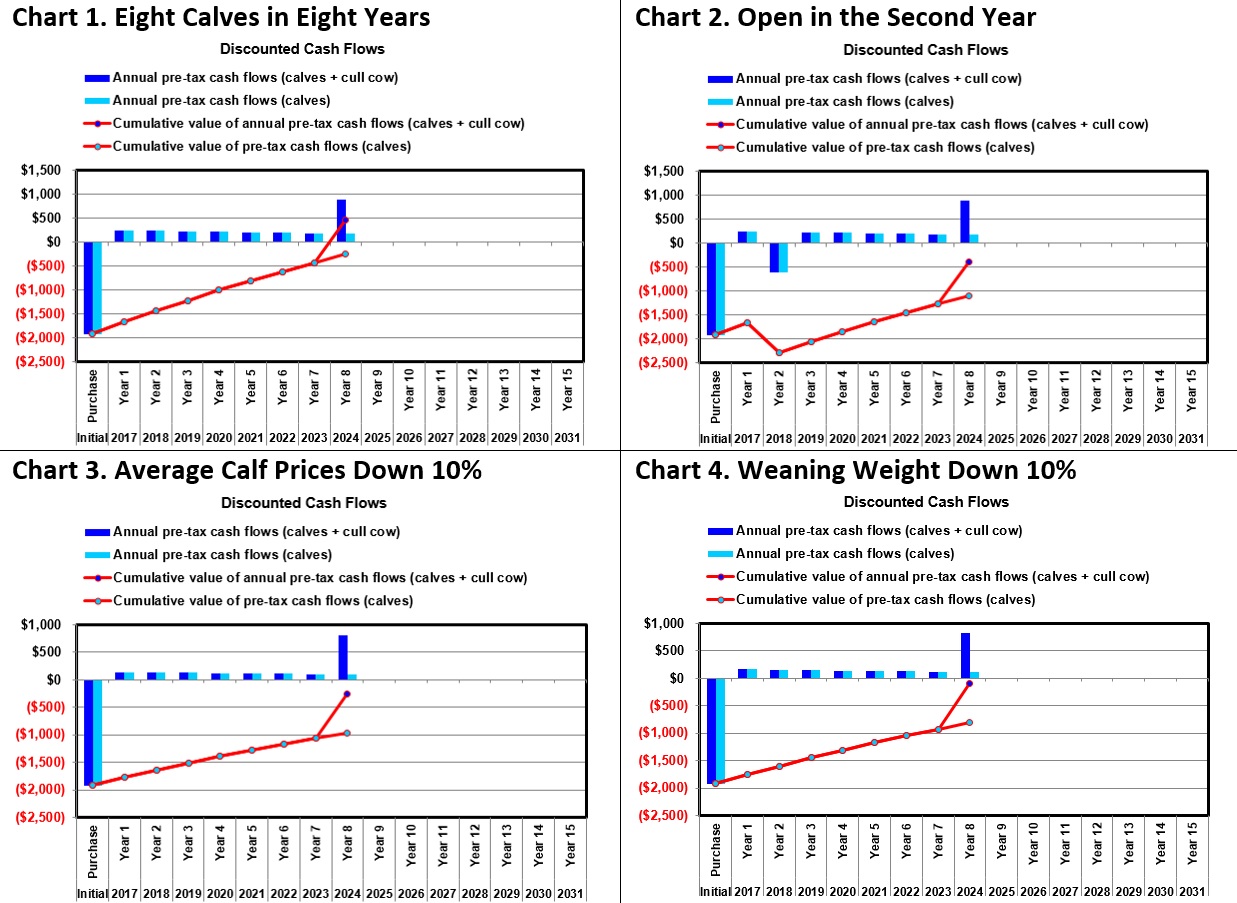Economics of Raising or Buying Heifers for Beef Cow Replacement
| Cow-Calf Cost of Production
|
The cost of herd replacement accounts for about 10% of total cow-calf cost of production (based on the 2013-17 average). It is the third largest cost component for a cow-calf operation, following winter feed (37%) and pasture (24%). Because replacement heifers represent a major cost for cow-calf producers, choosing a herd replacement strategy has important implications on cow-calf profitability. While many producers raise replacement heifers on farm, buying replacement heifers could cost less depending on the production cost of the operation and current market situations.
Costs of Raising Replacement Heifers
The main costs of developing a replacement heifer include winter feed, opportunity cost of the heifer, and breeding costs. These are all impacted by reproductive efficiency.
Winter feed costs. Hay and barley prices are both higher in 2018 due to dry conditions and reduced supplies, increasing the cost of raising replacement heifers. In June 2018, Alberta hay price at $130/ton was 13% higher than last year, and Lethbridge barley was $245/tonne in July, up 23% from last year. Winter feeding costs in Alberta for 2018-19 are projected to be 9% higher than last year, on a per cow basis.

Opportunity cost. The opportunity cost is the market value of the retained heifer calves that could have been sold at weaning. Higher cattle prices have increased the opportunity cost of raising replacement heifers. Heifer calf prices from October to December 2017 averaged $201/cwt, up 10% from $161/cwt in 2016. These are projected to be back down around 2016 levels in 2018.
Breeding cost. The cost of breeding will depend on the choice between natural service or artificial insemination, bull or semen costs, and the reproductive efficiency of the herd.
Reproductive efficiency. The total cost of raising replacement heifers will be impacted by how many heifers must be developed in order to have the correct number calving to replace cows that have been culled. According to the 2017 Western Canadian Cow-Calf Survey, the open rate for heifers was 12%. Using the Replacement Heifer Calculator developed by the Western Beef Development Centre, the costs of raising a replacement heifer are estimated for three groups of producers, namely Low-cost, Average, and High-cost producers, based on different wintering costs and reproductive efficiency assumptions (see Table 1).

Table 2 shows how the cost of raising replacement heifers would change for an average producer under different cattle price scenarios, while holding all other factors constant. It should be noted that while strong cattle prices increased the opportunity cost of raising replacement heifers, increased prices of open heifers sold as feeders can offset some of that impact.

To Raise or Buy Heifers?

The estimated cost per bred heifer for an average producer in 2018 at $1,840 per head is 4% lower than the annual average bred heifer price in 2017 at $1,921 per head. This means there is not much incentive for an average producer to either develop breeding heifers or purchase replacement heifers from a pure cost standpoint and therefore their decision for the fall of 2018 will be based on other preferences. Buying replacement heifers could allow producers to expand their herd quickly, improve herd genetics in less time, or free-up resources for alternative uses. On the other hand, raising replacement heifers on farm allows more genetic control and more control over disease, producers have better understanding of the replacement heifer’s background (Schulz and Gunn, 2014), and heifers are adapted to the environment and management of the operation.
Buying Replacement Heifers
When purchasing replacement heifers, producers should consider the economic value of replacements entering the herd. The value of a bred heifer can be indicated by its Net Present Value (NPV), which is the sum of future cash flows in present value dollars. It is affected not only by cash costs like annual maintenance and economic factors like salvage value and calf prices, but also by productivity factors such as reproductive life span and weaning weight.

Using the Net Present Value of Beef Replacement Females developed by Iowa State University, the NPV of replacement females and the cash flows throughout the animal’s lifespan are estimated with the following assumptions:
- Replacement heifers are purchased at $1,920/head in 2017
- Each heifer will produce eight calves in her lifetime
- Weaning weight at 550 lbs for steers and 540 lbs for heifers for future calves
- Calf prices averages $170/cwt
- Annual maintenance costs of $670/head
- Salvage value of $1,048/head in 2024
- Discount rate of 5% (due to interest, for example)
The results presented in Chart 1 below shows that the payback period for this heifer is projected to be 8 years, with the NPV being $450/head higher than the purchasing price. This means that the investment has future earnings greater than the current expense.
While the results in Chart 1 are based on an ideal scenario where the animal produces one marketable calf per year for the first eight years, that is not always the case. Charts 2, 3 and 4 show scenarios where the female is open in the second year, or average calf prices are down by 10%, or weaning weight are down 10%; in these scenarios, the future earnings do not cover the initial investment.
Conclusions
Replacement females represent a major cost for a cow-calf operation. Choosing the most economical replacement strategy has important implications on profitability. To make the economical choice each fall, producers should have a clear idea of the actual cost of raising replacement heifers on farm, have an open mind on alternative replacement options, and be aware of the long-term economic implications of these options. In addition to the cost factors, knowing the advantages and disadvantages of different replacement strategies and making the decision based on available resources and goals will help producers select the optimal replacement strategy for their operation.
Learn More
- Cost of siring calves: artificial insemination compared to natural service (BCRC Blog post)
- Bull Valuation Calculator (BCRC Calculator)
- Replacement Heifer Calculator (xlsx.file download)
- Net Present Value of Beef Replacement Females Calculator (Iowa State University)
- Partial Budget Decision Making Tool (Iowa State University)
References
- References
- Larson, 2011. What Does it Cost to Raise Replacement Heifers? http://westernbeef.org/pdfs/fact_sheets/2011/2011-04%20Cost_to_Raise_Replacement_Heifers.pdf, accessed April 5, 2018
- Real Agriculture, Calculating the True Cost of Replacement Heifers. https://www.realagriculture.com/2017/08/calculating-the-true-cost-of-replacement-heifers/, accessed on April 5, 2018
- Schulz and Gunn, 2014. Raising Versus Buying Heifers for Beef Cow Replacement. https://www.extension.iastate.edu/agdm/livestock/html/b1-73.html, accessed April 5, 2018
Click here to subscribe to the BCRC Blog and receive email notifications when new content is posted.
The sharing or reprinting of BCRC Blog articles is welcome and encouraged. Please provide acknowledgement to the Beef Cattle Research Council, list the website address, www.BeefResearch.ca, and let us know you chose to share the article by emailing us at [email protected].
We welcome your questions, comments and suggestions. Contact us directly or generate public discussion by posting your thoughts below.
